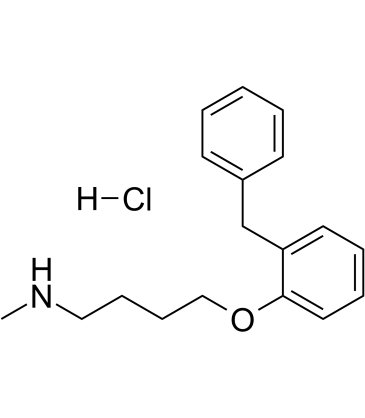
| 规格 | 价格 | 库存 | 数量 |
|---|---|---|---|
| 10 mM * 1 mL in DMSO |
|
||
| 1mg |
|
||
| 5mg |
|
||
| 10mg |
|
||
| 25mg |
|
||
| 50mg |
|
||
| 100mg |
|
||
| Other Sizes |
|
| 靶点 |
MAO-A (Ki = 4.2 μM); MAO-B (Ki = 46 μM)
|
|---|---|
| 体外研究 (In Vitro) |
在人脑突触体和人肝线粒体中,bifemelane 以剂量依赖性方式抑制 MAO-A,Kis 值分别为 4.2±0.2 和 14.1±0.7 μM [1]。在人脑突触体和人肝线粒体中,bifemelane 以剂量依赖性方式抑制 MAO-B 活性,Kis 值分别为 46.0±3.6 和 65.2±7.0 μM [1]。
|
| 体内研究 (In Vivo) |
Bifemelane(20-80 mg/kg;腹腔注射)以剂量依赖性方式降低旷场试验中的探索活动[3]。在强迫游泳试验中,Bifemelane(20-80 mg/kg;腹腔注射)缩短了不动时间[3],但剂量依赖性不明显,已达到最大剂量20 mg/kg。
|
| 酶活实验 |
4-(O-苄基苯氧基)-N-甲基丁胺是一种新型的精神药物,可抑制人脑突触体中的单胺氧化酶(MAO)。它竞争性抑制A型MAO(MAO-A),非竞争性抑制B型MAO-B。与胺底物犬尿胺相比,BP-N-甲基丁胺对MAO-a的亲和力高得多,并且它是MAO-a比MAO-B更有效的抑制剂。MAO-a和-B的Ki值分别为4.20和46.0微M,而MAO-a和-B与犬尿胺的Km值分别为44.1和90.0微M。通过透析培养混合物,发现BP-N-甲基丁胺对MAO-A和-B的抑制是可逆的。人胎盘和肝线粒体以及大鼠克隆性嗜铬细胞瘤细胞系PC12h中的MAO-A被BP-N-甲基丁胺竞争性抑制,而人肝线粒体中的MAO-B被非竞争性抑制(如人脑突触体)。BP-N-甲基丁胺不被MAO-A和-B氧化。考察了其他BP-N-乙基胺,如BP-N-亚甲基乙胺,-丙胺和-戊胺对MAO活性的影响。BP-N-甲基丁胺是MAO-A的最强抑制剂,BP-N-乙基乙胺和-丙胺竞争性地抑制MAO-B,而BP-N-亚甲基丁胺和-戊烯基胺非竞争性地阻止MAO-B。讨论了这些BP-N-甲基烷基胺对MAO-A和-B的抑制作用与其化学结构的关系[1]。
|
| 动物实验 |
Animal/Disease Models: Wistar male rats (230-270 g) Reserpine-induced hypothermia [3]
Doses: 20, 40, 80 mg/kg Route of Administration: Single intraperitoneal (ip) injection Experimental Results: Reserpine-induced hypothermia If it is too low, the maximum temperature will be diminished by 10℃. |
| 参考文献 |
|
| 其他信息 |
This study was designed with the rational aim of discussing the emerging antidepressant agents that are likely to bring positive landmark, tremendous improvement and significant impact to the management of patients with depression disorders. It also elaborates on the Agomelatine paradox vis-a-vis the other novel antidepressant agents. The emerging antidepressants are: selective monoamine oxidase inhibitors (MAOIs) such as bifemelane, pirlindole, toloxatone, selegiline, rasagiline and safinamide; serotonin-norepinephrine reuptake inhibitors (SNRIs) such as ansofaxine, nefopam and levomilnacipran; norepinephrine reuptake inhibitors (NRIs) such as Reboxetine, viloxazine, teniloxazine (also known as sulfoxazine or sufoxazine), and atomoxetine; Vilazodone (a serotonin 5-HT1A autoreceptor partial agonist with serotonin reuptake inhibition [SPARI]); Vortioxetine (a serotonin receptors antagonist with serotonin reuptake inhibition [SARI]); atypical antipsychotics such as olanzapine, quetiapine, risperidone, lurasidone, aripiprazole and brexpiprazole; N-methyl-d-aspartate (NMDA)-glutamatergic neurotransmission system blockers such as ketamine, CP-101,606 (traxoprodil), GLYX-13 (rapastinel), NRX-1074 (Apimostinel) and Riluzole. While Agomelatine (a melatonergic MT 1 and MT 2 receptors agonist and a selective serotonergic 5-HT 2B and 5-HT 2C receptors antagonist [MASSA]) remains a paradoxical agent that doesn't fit into any of the currently available classes of antidepressant agents and its pharmacological properties also deemed it unfit and inappropriate to be classified into another separate novel class of antidepressants contrary to the reports published in previous reference literatures. Lastly, this review remarkably advocates for the incorporation of the atypical antipsychotics and NMDA-glutamatergic ionoceptor blockers as new member classes of the antidepressant agents because of their clinically significant roles in the management of depression disorders[2].
|
| 分子式 |
C18H24CLNO
|
|---|---|
| 分子量 |
305.846
|
| 精确质量 |
305.155
|
| 元素分析 |
C, 70.69; H, 7.91; Cl, 11.59; N, 4.58; O, 5.23
|
| CAS号 |
62232-46-6
|
| 相关CAS号 |
Bifemelane;90293-01-9
|
| PubChem CID |
6917789
|
| 外观&性状 |
White to yellow solid powder
|
| 沸点 |
395.4ºC at 760 mmHg
|
| 熔点 |
117-121°C
|
| 闪点 |
169.2ºC
|
| LogP |
4.848
|
| tPSA |
21.26
|
| 氢键供体(HBD)数目 |
2
|
| 氢键受体(HBA)数目 |
2
|
| 可旋转键数目(RBC) |
8
|
| 重原子数目 |
21
|
| 分子复杂度/Complexity |
238
|
| 定义原子立体中心数目 |
0
|
| SMILES |
CNCCCCOC1=CC=CC=C1CC2=CC=CC=C2.Cl
|
| InChi Key |
MEAHDXWXNNDSAK-UHFFFAOYSA-N
|
| InChi Code |
InChI=1S/C18H23NO.ClH/c1-19-13-7-8-14-20-18-12-6-5-11-17(18)15-16-9-3-2-4-10-16;/h2-6,9-12,19H,7-8,13-15H2,1H3;1H
|
| 化学名 |
4-(2-benzylphenoxy)-N-methylbutan-1-amine hydrochloride
|
| 别名 |
MCI-2016 MCI 2016 MCI2016Bifemelane Bifemelanum Bifemelane HCl
|
| HS Tariff Code |
2934.99.9001
|
| 存储方式 |
Powder -20°C 3 years 4°C 2 years In solvent -80°C 6 months -20°C 1 month 注意: 请将本产品存放在密封且受保护的环境中(例如氮气保护),避免吸湿/受潮和光照。 |
| 运输条件 |
Room temperature (This product is stable at ambient temperature for a few days during ordinary shipping and time spent in Customs)
|
| 溶解度 (体外实验) |
DMSO : ~250 mg/mL (~817.42 mM)
|
|---|---|
| 溶解度 (体内实验) |
配方 1 中的溶解度: ≥ 2.08 mg/mL (6.80 mM) (饱和度未知) in 10% DMSO + 40% PEG300 + 5% Tween80 + 45% Saline (这些助溶剂从左到右依次添加,逐一添加), 澄清溶液。
例如,若需制备1 mL的工作液,可将100 μL 20.8 mg/mL澄清DMSO储备液加入400 μL PEG300中,混匀;然后向上述溶液中加入50 μL Tween-80,混匀;加入450 μL生理盐水定容至1 mL。 *生理盐水的制备:将 0.9 g 氯化钠溶解在 100 mL ddH₂O中,得到澄清溶液。 配方 2 中的溶解度: ≥ 2.08 mg/mL (6.80 mM) (饱和度未知) in 10% DMSO + 90% (20% SBE-β-CD in Saline) (这些助溶剂从左到右依次添加,逐一添加), 澄清溶液。 例如,若需制备1 mL的工作液,可将 100 μL 20.8 mg/mL澄清DMSO储备液加入900 μL 20% SBE-β-CD生理盐水溶液中,混匀。 *20% SBE-β-CD 生理盐水溶液的制备(4°C,1 周):将 2 g SBE-β-CD 溶解于 10 mL 生理盐水中,得到澄清溶液。 View More
配方 3 中的溶解度: ≥ 2.08 mg/mL (6.80 mM) (饱和度未知) in 10% DMSO + 90% Corn Oil (这些助溶剂从左到右依次添加,逐一添加), 澄清溶液。 1、请先配制澄清的储备液(如:用DMSO配置50 或 100 mg/mL母液(储备液)); 2、取适量母液,按从左到右的顺序依次添加助溶剂,澄清后再加入下一助溶剂。以 下列配方为例说明 (注意此配方只用于说明,并不一定代表此产品 的实际溶解配方): 10% DMSO → 40% PEG300 → 5% Tween-80 → 45% ddH2O (或 saline); 假设最终工作液的体积为 1 mL, 浓度为5 mg/mL: 取 100 μL 50 mg/mL 的澄清 DMSO 储备液加到 400 μL PEG300 中,混合均匀/澄清;向上述体系中加入50 μL Tween-80,混合均匀/澄清;然后继续加入450 μL ddH2O (或 saline)定容至 1 mL; 3、溶剂前显示的百分比是指该溶剂在最终溶液/工作液中的体积所占比例; 4、 如产品在配制过程中出现沉淀/析出,可通过加热(≤50℃)或超声的方式助溶; 5、为保证最佳实验结果,工作液请现配现用! 6、如不确定怎么将母液配置成体内动物实验的工作液,请查看说明书或联系我们; 7、 以上所有助溶剂都可在 Invivochem.cn网站购买。 |
| 制备储备液 | 1 mg | 5 mg | 10 mg | |
| 1 mM | 3.2696 mL | 16.3479 mL | 32.6958 mL | |
| 5 mM | 0.6539 mL | 3.2696 mL | 6.5392 mL | |
| 10 mM | 0.3270 mL | 1.6348 mL | 3.2696 mL |
1、根据实验需要选择合适的溶剂配制储备液 (母液):对于大多数产品,InvivoChem推荐用DMSO配置母液 (比如:5、10、20mM或者10、20、50 mg/mL浓度),个别水溶性高的产品可直接溶于水。产品在DMSO 、水或其他溶剂中的具体溶解度详见上”溶解度 (体外)”部分;
2、如果您找不到您想要的溶解度信息,或者很难将产品溶解在溶液中,请联系我们;
3、建议使用下列计算器进行相关计算(摩尔浓度计算器、稀释计算器、分子量计算器、重组计算器等);
4、母液配好之后,将其分装到常规用量,并储存在-20°C或-80°C,尽量减少反复冻融循环。
计算结果:
工作液浓度: mg/mL;
DMSO母液配制方法: mg 药物溶于 μL DMSO溶液(母液浓度 mg/mL)。如该浓度超过该批次药物DMSO溶解度,请首先与我们联系。
体内配方配制方法:取 μL DMSO母液,加入 μL PEG300,混匀澄清后加入μL Tween 80,混匀澄清后加入 μL ddH2O,混匀澄清。
(1) 请确保溶液澄清之后,再加入下一种溶剂 (助溶剂) 。可利用涡旋、超声或水浴加热等方法助溶;
(2) 一定要按顺序加入溶剂 (助溶剂) 。